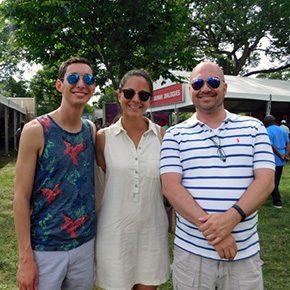Visitor Spotlight: Reflections on the Festival

What performances or demonstrations at Folklife Festival did you enjoy the most? What brought you to the Festival? Did any of the programming remind you of your own cultural traditions or personal experiences?
I wanted to find out these answers, so I decided to interview a random selection of visitors throughout the Folklife Festival, along with my fellow research intern Sara Dufour. To find potential interviewees, we made sure to walk around the Festival late in the afternoon to give visitors plenty of time to see events. We also made sure to interview people of various ages and cultural backgrounds in order to collect a myriad of potential responses.
Here are some highlights of our results.

Did any of the Festival content remind you of your personal traditions?
Mandy W: Not really, although there’s some commonality in almost all the traditions—like some of the dances. I’m of Scots-Irish background, and some of the dances seem similar to things you see in Irish and Scottish step dancing. And that was kind of fun!

What brought you to the Festival?
Bill J: It’s great every year. I have been here since it started. The first one was basically a bunch of hippies sitting under a tree playing folk music. There was one stage, and the whole thing was really laid back, and there were clouds of marijuana smoke along the Festival. There were bands popping up here and there and everybody wandering around.

Did anything here remind you of personal traditions or experiences?
Daniel B: I feel like I don’t have any personal traditions or experiences!
Cecilia M: I’m half Mexican, so in the Sounds of California La Cueva tent, there was the artisan who makes all the wood craft, and he has the Virgin Mary in his tent with his little altar and everything. That’s just like my mom’s house.

What demonstrations stood out to you?
Elizabeth H: I think the pintxos. They were demonstrating how to make them. One guy was talking in Basque and the other one was translating for him, and that was really neat to hear both languages, and of course to see what they were doing—and to learn that their national pintxo is named after the movie Gilda with Rita Hayworth. You name your national snack after Rita Hayworth!

Which performers stood out to you today?
Johnny M: I would say those guys with the really traditional costumes with the cowbells on the back. We had just gotten here and they were standing around initially, and then they started marching off jauntily and, you know, making quite a bit of noise. So we ended up following them. It was like they were Pied Pipers.
Did anything at the Festival remind you of your own traditions?
Gina P: When I was younger, my family used to have big parties in the backyard and have a band and roast a pig. All the older people would dance, but I was too afraid to join in. Now I regret that. So it was really nice to see younger people carrying on their traditions.
Johnny M: Europeans grow up with one set tradition of dance, and we were lamenting the fact that we don’t have that so much. We all have mixed traditions, with lots of different aspects of different cultures, and actually have some things that we don’t realize are cultural.
Want to answer these questions for yourself? Tell us in the comments!
Lila Spitz is a Center for Folklife and Cultural Heritage intern who worked in the Txiki-Txoko Kids’ Corner during the 2016 Folklife Festival. In May she graduated with a bachelor of arts in American studies from the University of Mary Washington.
Visitor photos by Lila Spitz and Sara Dufour.

